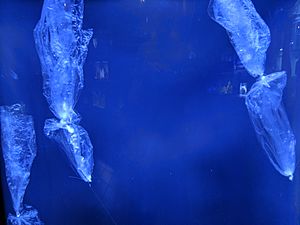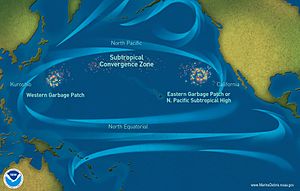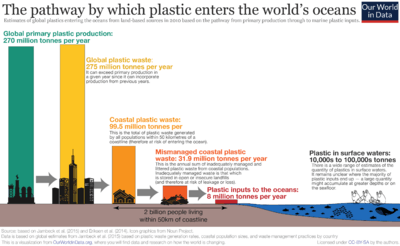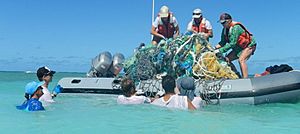Marine plastic pollution facts for kids
Marine plastic pollution (or plastic pollution in the ocean) is a type of marine pollution by plastics. These plastics can range in size from large original materials like bottles and bags to microplastics and nanoplastics, which are very small pieces of plastic. About eighty percent of marine debris is plastic. Plastic garbage that floats on or in the ocean's water is known to harm marine life (plants and animals that live in the ocean). They can become entangled in it or suffocated by it. Plastics that are small enough to be eaten or breathed (intentionally or unintentionally) by animals harm their organs.
The ten countries that put the most plastic in the ocean are China, Indonesia, the Philippines, Vietnam, Sri Lanka, Thailand, Egypt, Malaysia, Nigeria, and Bangladesh. Most of the garbage enters the ocean through rivers that are connected to these countries.
Plastics cannot biodegrade in the way many other substances do. They will photodegrade when they are exposed to the sun, but only under the right conditions.
Some companies are trying to cut down on plastic pollution by making and packaging their products differently. Many ideas exist for cleaning up plastic in the oceans. These ideas include trapping plastic particles at river mouths before entering the ocean and cleaning up the ocean gyres.
Scope of the problem

Much of the plastic that is used in the day-to-day life of humans is not recycled. Up to 90% of it is thrown into the ocean. Scientists have guessed that there are 15-51 trillion pieces of plastic currently in the ocean. It is thought that 9 million tons (over 8 million metric tons) of plastic find its way to the ocean every year. Scientists estimate that if this continues, there will be more plastic (by weight) than fish in the ocean by 2050. Ocean currents move plastic and other garbage long distances. Sometimes plastic from extremely far away can be found on the shores of remote islands.
Microplastics
The biggest threat of ocean plastic pollution comes from microplastics. These are small fragments of plastic debris, usually less than 0.195 inches wide. Sometimes the plastics are made to be small (like microbeads in soaps). Other times, microplastics are formed from larger pieces of plastic that have been broken down by weathering processes.
Harmful effects of microplastics
Microplastics are often swallowed by marine organisms at the base of the food chain, like plankton and fish larvae. Larger animals eat them, and the microplastics that are in them. Sometimes humans eat fish that have eaten smaller fish that have eaten microplastics, putting the toxic chemicals into us. Microplastics can concentrate in the gills and intestines of marine life. This makes it difficult for them to breathe and eat and can make them die. Many studies have found plastics and microplastics in the stomach contents of marine animals.
As plastics photodegrade, they can release toxic chemicals such as bisphenol A, PCBs, and derivatives of polystyrene. They can cause many health issues in humans and animals as we eat, drink, and breathe the chemicals from the plastics. Some of these issues include harming the endocrine system, suppressing the immune system, decreasing fertility, confusing the central nervous system, and irritating the gastrointestinal tract.
Macroplastics
Macroplastics are larger plastic waste that has not yet broken down into smaller pieces. Examples of macroplastics are water bottles, plastic food packaging, and plastic bags.
Harmful effects of macroplastics
Larger plastic waste can be ingested (eaten or drunk) by marine animals and birds. The plastic fills their stomachs and makes them feel full when they have taken in no nutrition. This can cause them to die of starvation. In March 2019, a dead Cuvier's beaked whale washed up in the Philippines with 88 pounds of plastic in its stomach.
Marine animals can also be entangled in larger pieces of plastic, which can cause them to starve, suffocate, or be killed by predators.
Sources and amounts
The largest single type of plastic pollution (~10 %) and most large plastic in the oceans is discarded and lost nets from the fishing industry. Many merchant ships and cruise ships dump cargo, sewage, used medical equipment, food packaging, and other types of waste that contain plastic into the ocean.

Sometimes items like the ones listed above are made on land and dumped by ships. Other times, plastic in the ocean enters because it has been thrown (from land) into rivers that run into the ocean. Landfills are another source that is concerning to scientists.
A 1994 study of the seabed using trawl nets in the North-Western Mediterranean around the coasts of Spain, France, and Italy reported an average of 1,935 items of debris per 0.386 square miles (1 km). 77% of the trash was plastic. 93% of the plastic was plastic bags. One study estimated that there are more than 5 trillion plastic pieces (defined into the four classes of small microplastics, large microplastics, meso- and macroplastics) afloat at sea. In 2020, Australia's national science agency CSIRO estimated that 14 million metric tons of microplastics are already on the ocean floor. Another study in 2020 showed 10 times as much plastic in the Atlantic Ocean than previously estimated to be there.
Accumulation sites
Plastic in the ocean has been shown to follow ocean currents which eventually form into what is known as Great Garbage Patches. The most famous garbage patch is the Great Pacific garbage patch. It is believed to be twice the size of Texas: 270,271 to 5,791,532 square miles (700,000 to 15,000,000 square kilometers). Other patches include the North Atlantic garbage patch, the South Atlantic garbage patch, the South Pacific garbage patch, and the Indian Ocean garbage patch.
Research studies
Microplastic pollution in the deep sea is still being studied. Scientists are examining the plants, animals, and sea floor at deep depths to better understand the issue. They are finding that microplastics are located in the deep sea and in the animals that live there.
Reduction Efforts
We can reduce the amount of plastic that pollutes the ocean by:
- changing how we package products,
- collecting plastic that is already in the ocean, and
- reusing plastic waste as something else (recycling).
In 2019, a research group led by scientists at Washington State University found a way to turn plastic waste products into jet fuel. Blest Co. Ltd. developed technology that can change plastic waste into valuable liquid fuels including gasoline, diesel, and kerosene.
National and state agencies are also encouraging citizens to be careful in their use of plastic. Some of these agencies are the EPA, the National_Park_Service, the USDA, the FDA, and the DOE.
See also
 In Spanish: Contaminación marina por plástico para niños
In Spanish: Contaminación marina por plástico para niños
Images for kids
-
Washed-up plastic waste on a beach in Singapore
-
Sea turtle entangled in a ghost net
-
Northern gannet on Helgoland, trapped in their own nests, build only of old nets and other plastic waste.
-
The remains of an albatross containing ingested flotsam









